Complete Solutions to JEE Main And Advanced of chapter HEAT AND THERMODYNAMICS of Class 11 book with complete answers and questions
| Class 11 | PHYSICS |
| Chapter | HEAT AND THERMODYNAMICS |
| SUNIL BATRA | JEE Main And Advanced |
| Number Of Questions | 100 |
| Academic Year | 2023-24 |
One mole of a mono-atomic ideal gas is mixed with one mole of a diatomic ideal gas. The molar specific heat of the mixture at constant volume is ……
View SolutionThe variation of temprature of a material as heat is given to it at a constant rate is shown in the figure. The material is in solid state at the point O. The state of the material at the point P is…..
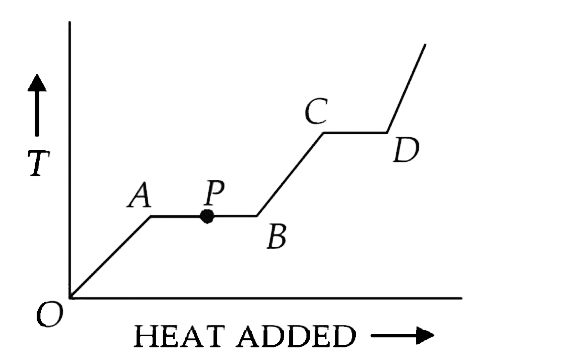
View SolutionDuring an experiment, an ideal gas is found to obey an additional law `VP^2=constant,` The gas is initially at a temprature T, and volume V. When it expands to a volume `2V,` the temperature becomes…….
View Solution300 grams of water at `25^@ C` is added to 100 grams of ice at `0^@ C.` The final temperature of the mixture is …..`@C`
View SolutionThe earth receives at its surface radiation from the sun at the rate of `1400 Wm^-2.` The distance of the centre of the sun from the surface of the earth is `1.5xx10^11 m` and the radius of the sun is `7xx10^8m.` Treating the sun as a black body, it follows from the above data taht its surface temperature is ......K
View SolutionA solid copper sphere (density rho and specific heat c) of radius r at an initial temperature `200K` is suspended inside a chamber whose walls are at almost `0K.` The time required for the temperature of the sphere to drop to 100K is …….
View SolutionA point source of heat of power P is placed at the centre of a spherical shell of mean radius R. The material of the shell has thermal conductivity K. If the temperature difference between the outer and inner surface of the shell in not to exceed T, the thickness of the shell should not be less than .......
View SolutionA substance of mass M kg requires a power input of P wants to remain in the molten state at its melting point. When the power source is turned off, the sample completely solidifies in time t seconds. The latent heat of fussion of the substance is …….
View SolutionA container of volume `1m^3` is divided into two equal parts by a partition. One part has an ideal gas at 300K and the other part is vacuum. The whole system is thermally isolated from the surroundings. When the partition is removed, the gas expands to occupy the whole volume. Its temperature will now be .......
View SolutionAn ideal gas with pressure P, volume V and temperature T is expanded isothermically to a volume 2V and a final pressure `P_i,` If the same gas is expanded adiabatically to a volume 2V, the final pressure `P_a.` The ratio of the specific heats of the gas is 1.67. The ratio `(P_a)/(P_1)` is .......
View SolutionTwo metal cubes A and B of same size are arranged as shown in Figure. The extreme ends of the combination are maintened at the indicated temperatures. The arrangement is thermally insulted. The coefficients of thermal conductivity of A and B are `300W//m ^@C and 200 W//m^@C,` respectively. After steady state is reached the temperature t of the interface will be ......
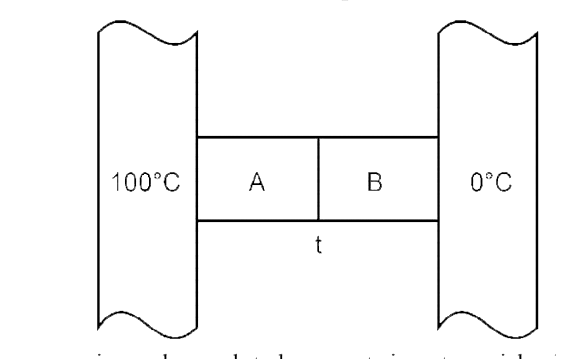
View SolutionA ring shaped tube contain two ideal gases with equal masses and relative molar masses `M_1=32 and M_2=28.`
The gases are separated by one fixed partion and another movable stopper S which can move freely without friction inside the ring. The angle `alpha` as shown in the figure is ...... degrees.
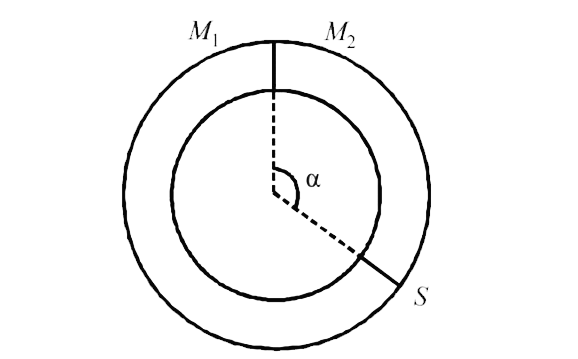
View SolutionEarth recieves `1400 W//m^2` of solar power. If all the solar energy falling on a lens of area `0.2m^2` is focused on to a block of ice of mass 280 grams, the time taken to melt the ice will be….. Minutes. `(Latent heat of fusion of ice=3.3xx10^5J//kg.)`
View SolutionThe root-mean square speeds of the molecules of different ideal gses, maintained at the same temperature are the same.
View SolutionThe volume V versus temperature T graphs for a cetain amount of a perfect gas at two pressure `p_1 and p_2` are as shown in Fig. It follows from the graphs that `p_1` is greater than `p_2.`

View SolutionTwo different gases at the same temperature have equal root mean square velocities.
View SolutionThe ratio of the velocity of sound in Hydrogen gas `(gamma=7/5)` to that in Helium gas `(gamma=5/3)` at the same temperature is sqrt(21/3).
View SolutionThe curves A and B in the figure shown P-V graphs for an isothermal and an adiabatic process for an idea gas. The isothermal process is represented by the curve A.
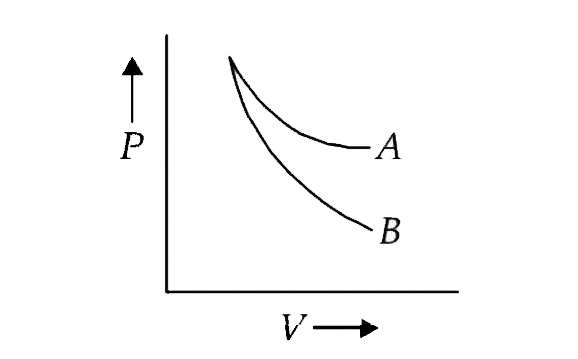
View SolutionAt a given temperature, the specific heat of a gas at constant pressure is always greater than its specific heat at constant volume.
View SolutionThe root mean square (rms) speed of oxygen molecules `(O_2)`
at a certain tempereture T (degree absolute) is V. If the temperatrue is doubled and oxygen gas dissociates into atomic oxygen, the rms speed remains unchanged.
View SolutionTwo spheres of the same material have radii 1m and 4m and temperatures 4000K and 2000K respectively. The energy radiated per second by the first sphere is greater than that by the second.
View SolutionA constant volume gas thermometer works on
View SolutionA metal ball immersed in alcohol weights `W_1 at 0^@C and W_2 at 50^@C.` The coefficient of expansion of cubical the metal is less than that of the alcohol. Assuming that the density of the metal is large compared to that of alcohol, it can be shown that
View SolutionA wall has two layers A and B, each made of different material. Both the layers have the same thickness. The thermal conductivity of the meterial of A is twice that of B . Under thermal equilibrium, the temperature difference across the wall is `36^@C.` The temperature difference across the layer A is
View SolutionAn ideal monatomic gas is taken round the cycle ABCDA as shown in the P-V diagram. The work time during the cycle is
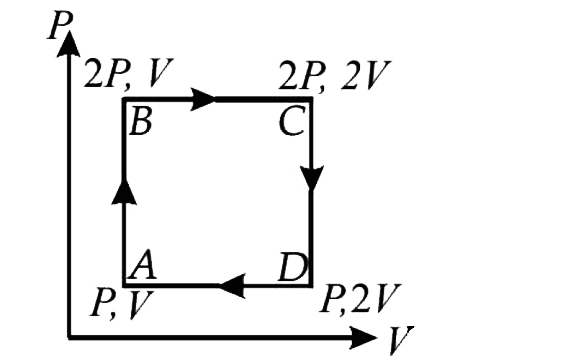
View SolutionIf one mole of a monatomic gas `(gamma=5/3)` is mixed with one mole of a diatomic gas `(gamma=7/5),` the value of gamma for mixture is
View SolutionFrom the following statements concerning ideal gas at any given temperature T, select the correct one (s)
View SolutionThree rods of identical area of cross-section and made from the same metal from the sides of an isosceles triangle. ABC, right angled at B. The points A and B are maintained at temperatures T and `sqrt 2T` RESPECTIVELY. In the steady state the temperature of the point C is `T_(C)`.
Assuming that only heat conduction takes place , `T_(C) / T` is equal to
View SolutionTwo metallic spheres `S_1 and S_2` are mode of the same material and have got identical surface finish. The mass of `S_1` is thrice that of `S_2.` Both the spheres are heated to the same high temperature and placed in the same room having lower temperature but are thermally insulted from each other. The ratio of the initial rate of coiling of `S_1` to that of `S_2` is
View SolutionThe average translational kinetic energy of `O_2` (relative molar mass 32) molecules at a particular temperature is 0.048eV. The translational kinetic energy of `N_2` (relative molar mass 28) molecules in eV at the same temperature is
View SolutionA vessel contains 1 mole of `O_2` gas (relative molar mass 32) at a temperature T. The pressure of the gas is P. An identical vessel containing one mole of He gas (relative molar mass 4) at temperature 2T has a pressure of
View SolutionA spherical black body with a radius of 12cm radiates 450W power at 500K. If the radius were halved and the temperature doubled, the power radiated in watt would be
View SolutionA closed compartment containing gas is moving with some acceleration in horizontal direction. Neglect effect of gravity. Then the pressure in the compartment is
View SolutionA gas mixture consists of 2 moles of oxygen and 4 moles of argon at temperature T. Neglecting all vibrational modes, the total internal energy of the system is
View SolutionThe ratio of the speed of sound in nitrogen gas to that in helium gas, at 300K is
View SolutionA monatomic ideal gas, initially at temperature `T_1,` is enclosed in a cylinder fitted with a frictionless piston. The gas is allowed to expand adiabatically to a temperature `T_2` by releasing the piston suddenly. If `L_1 and L_2` are the length of the gas column before expansion respectively, then `(T_1)/(T_2)` is given by
View SolutionA block of ice at `-10^@C` is slowly heated and converted to steam at `100^@C.` Which of the following curves represents the phenomenon qualitatively?
View SolutionAn ideal gas is initially at temperature T and volume V. Its volume is increased by `DeltaV` due to an increase in temperature `DeltaT,` pressure remaining constant. The quantity `delta=(DeltaV)/(VDeltaT)` varies with temperature as
View SolutionStarting with the same initial conditions, an ideal gas expands from volume `V_1 to V_2` in three different ways. The work done by the gas is W_1 if the process is purely isothermal, `W_2`if purely isobaric and `W_3` if purely adiabatic. Then
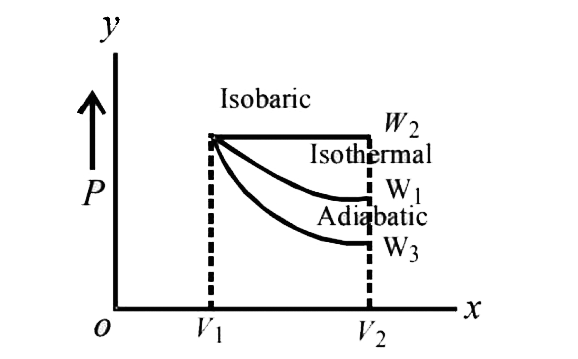
View SolutionThe plots of intensity versus wavelength for three black bodies at temperature `T_1,T_2 and T_3` respectively are as shown. Their temperatures are such that
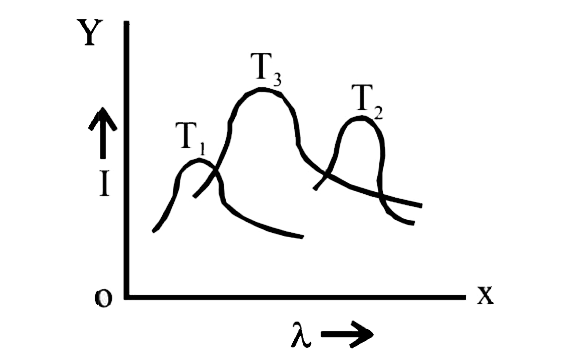
View SolutionThree rods made of same material and having the same cross-section have been joined as shown. In the figure.Each rod is of the same length. The left and right ends are kept at `0^@C and 90^@C` respectively. The temperature of the junction of the three rods will be
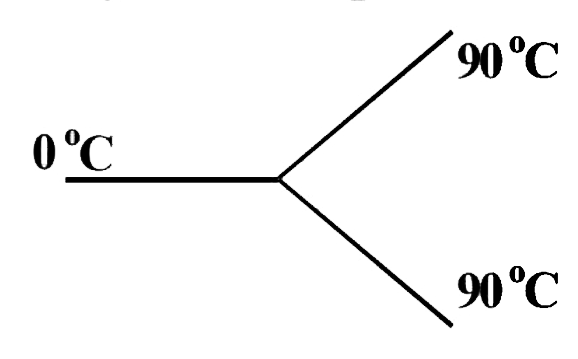
View SolutionIn a given process on an ideal gas, `dW=0 and dQlt0.` Then for the gas
View SolutionP-V plots for two gases during adiabatic processes are shown in the figure. Plots 1 and 2 should corresponds respectively to
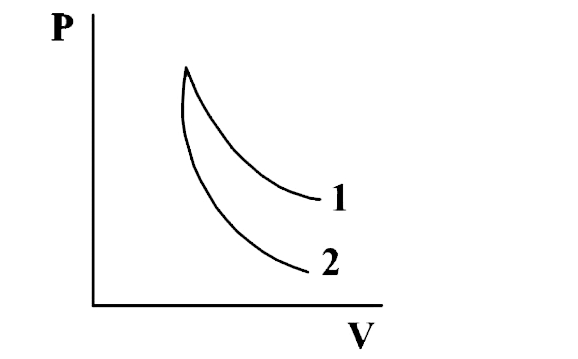
View SolutionWhen a block of iron in mercury at `0^@C,` fraction `K_1`of its volume is submerged, while at the temperature `60^@C,` a fraction `K_2` is seen to be submerged. If the coefficient of volume expansion of iron is `gamma_(Fe)` and that of mercury is `gamma_(Hg),` then the ratio `(K_1)//(K_2)` can be expressed as
View SolutionAn ideal gas is taken through the cycle `AtoBtoCtoA,` as shown in the figure, If the net heat supplied to the gas in the cycle is 5J, the work done by the gas in the process CtoA is
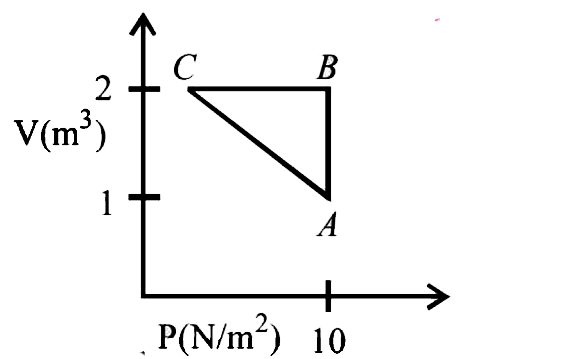
View SolutionWhich of the following graphs correctly represents the variation of `beta=-(dV//dP)/V`
with P for an ideal gas at constant temperature?
View SolutionAn ideal Black-body at room temperature is thrown into a furnace. It is observed that
View SolutionThe graph, shown in the adjacent diagram, represents the variation of temperature (T) of two bodies, x and y having same surface area, with time (t) due to the emission of radiation. Find the correct relation between the emissivity and absorptivity power of the two bodies
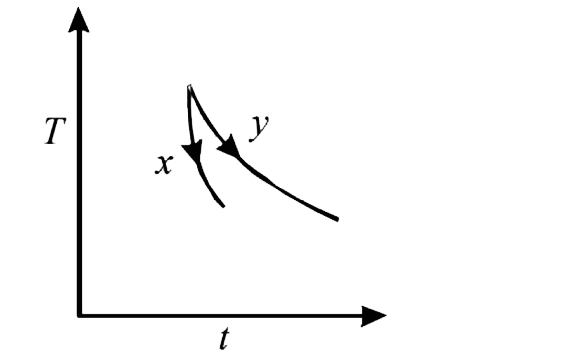
View SolutionTwo rods, one of aluminium and the other made of steel, having initial length `l_1 and l_2` are connected together to from a single rod of length `l_1+l_2.` The coefficients of linear expansion for aluminium and steel are `alpha_a and alpha_s` and respectively. If the length of each rod increases by the same amount when their temperature are raised by `t^0C,` then find the ratio `l_1//(l_1+l_2)`
View SolutionThe PT diagram for an ideal gas is shown in the figure, where AC is an adiabatic process, find the corresponding PV diagram.
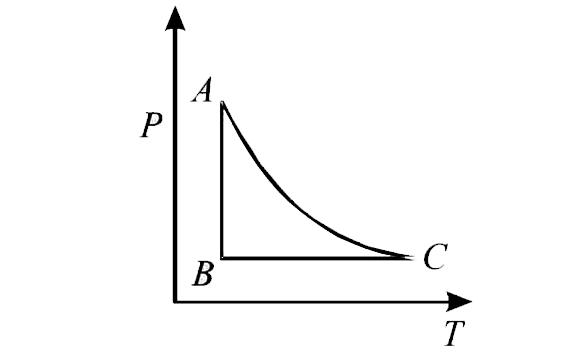
View Solution2kg of ice at `20^C@` is mixed with 5kg of water at `20^C@` in an insulating vessel having a negligible heat capacity. Calculate the final mass of water remaining in the container. It is given that the specific heats of water & ice are `1kcal//kg//^@C 0.5`
`kcal//kg//^@C` while the latent heat of fusion of ice is `80kcal//kg`
View SolutionThree discs A,B and C having radii 2,4 and 6 cm respectively are coated with carbon black. Wavelength for maximum intensity for the three discs are 300,400 and 500 nm respectively. If `Q_A,Q_B and Q_C`are power emitted by A,B and D respectively, then
View SolutionIf liquefied oxygen at 1 atmospheric pressure is heated from 50K to 300k by supplying heat at constant rate. The graph of temperature vs time will be
View SolutionTwo identical rods are connected between two containers on of tehm is at `100^@C` and another is at `0^@C.` If rods are connected in parralel them the rate of melting of ice is `q_1 gm//sec.`
If they are connected in series then the rate is `q_2.` The ratio `q_2//q_1` is
View SolutionAn ideal gas is initially at `P_1,V_1` is expands to `P_2,V_2` and then compressed adiabatically to the same volume `V_1` and pressure `P_3.` If W is the net work done by the gas in complete process which of the following is true.
View SolutionVariation of radiant energy emitted by sun, filament of tungsten lamp and welding arc as a function of its wavelength is shown in figure. Which of the following option is the correct match?
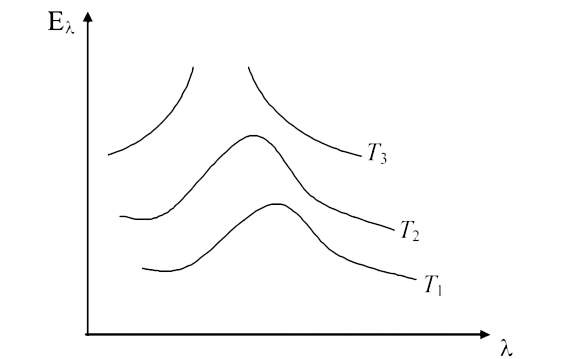
View SolutionIn which of the following process, convection does not take place primarily
View SolutionA spherical body of area A, and emissivity e = 0.6 is kept inside a black body. What is the rate at which energy is radiated per second at temperature T
View SolutionCalorie is defined as the amount of heat required to raise temperature of 1 g of water by `1^@C` abd it is defined under which of the following conditions?
View SolutionWater of volume 2 litre in a container is heated with a coil of `1kW at 27^@C.` The lid of the container is open and energy dissipates at rate of `160J//s.` In how much time temperature will rise from `27^@C to 77^@C` [Given specific heat of water is
`4.2kJ//kg`]
View SolutionWater is filled up to a height `h` in a beaker of radiys `R` as shown in the figure. The density of water is `rho`, the surface tension of water is `T ` and the atmospheric pressure is `P_(0)`. Consider a vertical section `ABCD` of the water column through a diameter of the beaker. The force on water on one side on this section by water on the other side of this section has magnitude
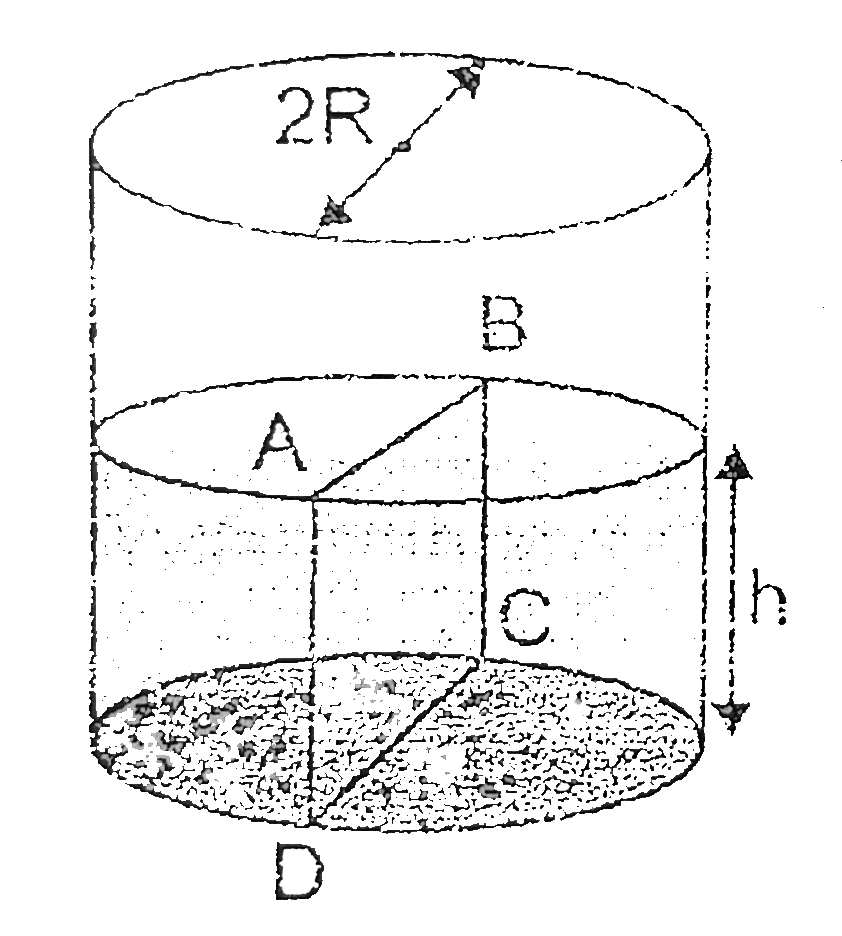
View SolutionAn ideal gas is expanding such that `PT^@=constant.` The coefficient of colume expansion of the gas is-
View SolutionA real gas behaves like an ideal gas if its
View Solution5.6 liter of helium gas at STP is adiabatically compressed to 0.7 liter. Taking the initial temperature to be `T_1,` the work done in the process is
View SolutionA mixture of 2 moles of helium gas `(atomic mass=4amu)` and 1 mole of argon gas `(atomic mass=40amu)` is kept at 300K in a container. The ratio of the rms speeds `((v_(rms)(helium))/((v_(rms)(argon))` is
View SolutionTwo moles of ideal helium gas are in a rubber balloon at `30^@C.` The balloon is fully expandable and can be assumed to require no energy in its expansion. The temperature of the gas in the balloon is slowly changed to `35^@C.` The amount of heat required in raising the temperature is nearly (take R
`=8.31 J//mol.K`)
View SolutionTwo rectangular blocks, having identical dimensions, an be arranged either in configuration-I or in configuration-II as shown in the figure. One of the blocks has thermal conductivity k and the other 2k. The temperature difference between the ends along the x-axis is the same in both the configurations. It takes 9s to transport a certain amount of heat from the hot end to the cold end in the configuration-I. The time to transport the same amount of heat in the configuration-II is
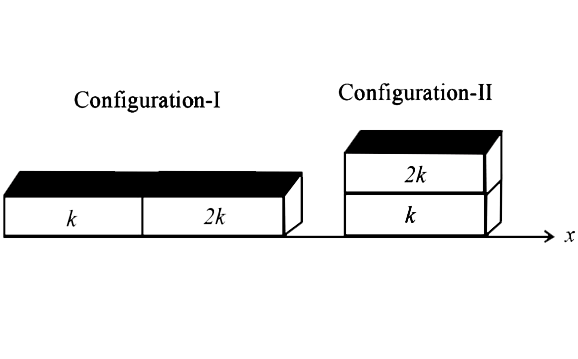
View SolutionTwo non-reactive monoatomic ideal gases have their atomic masses in the ratio `2:3.` The ratio of their partial pressures, when enclosed in a vessel kept at a constant temperature, is `4:3.` The ratio of their densities is
View SolutionParallel rays of light of intensity `I=912 WM^-2` are incident on a spherical black body kept in surroundings of temperature 300K. Take Stefan-Boltzmann constant `sigma=5.7xx10^-8`
`Wm^-2K^-4` and assume that the energy exchange with the surroundings is only through radiation. The final steady state temperature of the black body is close to
View SolutionA water cooler of storages capacity 120 liters can cool water at a constant rate of P watts. In a closed circulation system (as shown schematically in the figure), the water from the cooler is used to cool an external device that generates constantly 3kW of heat (thermal load). The temperature of water fed into the device cannot exceed `30^@C` and the entire stored 120 liters of water is initially cooled to `10^@C.` The entire system is thermally insulated. The minimum value of P ( in watts) for which the device can be operated for 3hours is

(Specific heat of water is `4.2kJkg^-1K^-1` and the density of water is `1000kgm^-3`)
View SolutionA gas is enclosed in a cylinder with a movable frictionless piston. Its initial thermodynamic state at pressure `P_i=10^5` Pa and volume `V_i=10^-3m^3` changes to a final state at `P_f=(1//32)xx10^5Pa and V_f=8xx10^-3m^3` in an adiabatic quasi-static process, such that `P^3V^3=constant.` Consider another thermodynamic process that brings the system form the same initial state to the same final state in two steps: an isobaric expansion at `P_i` followed by an isochoric (isovolumetric ) process at volume `V_r.` The amount of heat supplied to the system i the two-step process is approximately
View SolutionThe ends Q and R of two thin wires, PQ and RS, are soldered (joined) together. Initially each of the of wire has a length of 1m at `10^@C.` Now the end P is maintained at `10^@C,` while the ends S is heated and maintained at `400^@C.` The system is thermally insultated from its surroundings. If the thermal conductivity of wire PQ is twice that of the wire RS and the coefficient of linear thermal expansion of PQ is `1.2xx10^-5K^-1,` the change in length of the wire PQ is
View SolutionAt room temperature the rms speed of the molecules of a certain diatomic gas is formed to be `1930m//sec` The gas is .
View Solution70 calories of heat required to raise the temperature of 2 moles of an ideal gas at constant pressure from `30^@Cto 35^@C.` The amount of heat required (in calories) to raise the temperature of the same gas through the same range `(30^@C to 35^@C)` at constant volume is:
View SolutionSteam at `100^(@)C` is passed into `1.1 kg` of water contained in a calorimeter of water equivalent `0.02kg` at `15^(@)C` till the temperature of the calorimeter and its content rises to `80^(@)C`. What is the mass of steam condensed? Latent heat of steam = `536 cal//g`.
View SolutionA cylinder of radius R made of a material of thermal conductivity `K_1` is surrounded by a cylinderical shell of inner radius R and outer radius 2R made of a material of thermal conductivity `K_2`. The two ends of the combined system are maintained at two different temperatures. There is no loss of heat across the cylindrical surface and the system is in steady state. The effictive thermal conductivity of the system is
View SolutionFor an ideal gas :
View SolutionWhen an ideal diatomic gas is heated at constant pressure, the fraction of the heat energy supplied which increases the internal energy of the gas is
View SolutionThree closed vessels A, B and C are at the same temperature T and contain gasses which obey the Maxwellian distribution of velocities. Vessel A contain only `O_2 and N_2`. If the average speed of the `O_2` molecules in vessel A is `v_1` that of the `N_2` molecules in vessel B us `v_2,` the average speed of the `O_2` molecules in vessel C is
View SolutionAn ideal gas is taken from the state A (pressure P, volume V) to the state B (pressure `p//2`, volume 2V) along a straight line path in the P-V diagram. Select the correct statement (s) from the following :
View SolutionTwo bodies A and B ahave thermal emissivities of 0.01 and 0.81 respectively. The outer surface areas of the two bodies are the same. The two bodies emit total radiant power of the same rate. The wavelength `lambda_B` corresponding to maximum spectral radiancy in the radiation from B shifted from the wavelength corresponding to maximum spectral radiancy in the radiation from A, by `1.00mum.` If the temperature of A is 5820K:
View SolutionThe temperature of an ideal gas is increased from 120K to 480K. If at 120K the root-mean-squre velocity of the gas molecules is v, at 480K it becomes
View SolutionA given quantity of a ideal gas is at pressure P and absolute temperature T. The isothermal bulk modulus of the gas is
View SolutionTwo cylinders A and B fitted with pistons contain equal amounts of an ideal diatomic gas at 300K. The piston of A is free to move, while that B is held fixed. The same amount of heat is given to the gas in each cylinder. If the rise in temperature of the gas in A is 30K, then the rise in temperature of the gas in B is
View SolutionDuring the melting of a slab of ice at 273K at atmospheric pressure,
View SolutionA blackbody is at a temperature of 2880K. The energy of radiation emitted by this object with wavelength between 499nm and 500nm is `U_1`, between 999nm and 1000nm is `U_2` and between 1499 nm and 1500 nm is `U_3`. The Wien constant `b=2.88xx10^6nmK`. Then
View SolutionA bimetallic strip is formed out of two identical strips one of copper and the other of brass. The coefficients of linear expansion of the strip goes up by `DeltaT`and the strip bends to from an arc of radius of curvature R. Then R is.
View SolutionTwo identical containers A and B with frictionless pistons contain the same ideal gas at the same temperature and the same velocity V. The mass of the gas in A is `m_A,` and that in B is `m_B`. The gas in each cylinder is now allowed to expand isothermally to the same final volume 2V. The changes in the pressure in A and B are found to be `DeltaP and 1.5 DeltaP` respectively. Then
View SolutionLet `barv,v_(rms) and v_p` respectively denote the mean speed. Root mean square speed, and most probable speed of the molecules in an ideal monatomic gas at absolute temperature T. The mass of a molecule is m. Then
View SolutionA vessel contains a mixture of one mole of oxygen and two moles of nitrogen at 300K. The ratio of the average rorational kinetic energy per `O_2` molecules to that per `N_2` molecules is
View SolutionA black body of temperature T is inside chamber of `T_0` temperature initially. Sun rays are allowed to fall from a hole in the top of chamber. If the temperature of black body (T) and chamber `(T_0)` remains constant, then
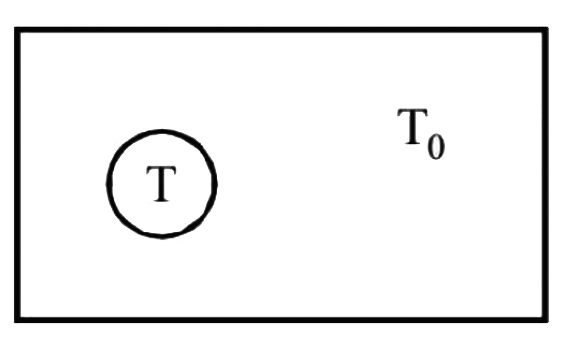
View Solution`C_v and C_p` denote the molar specific heat capacities of a gas at costant volume and constant pressure, respectively. Then
View SolutionThe figure shows the P-V plot of an ideal gas taken through a cycle ABCDA. The part ABC is a semi-circle and CDA is half of an ellipse. Then,
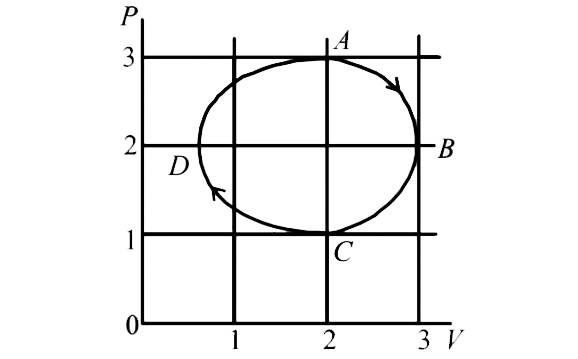
View SolutionOne mole of an ideal gas in initial state A undergoes a cylic process ABCA, as shown in the figure. Its pressure at A is `P_0`. Choose the correct option (s) from the following
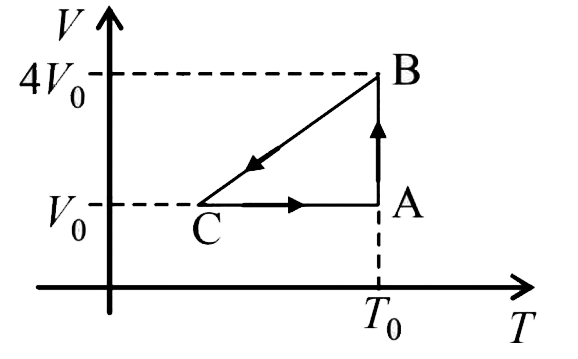
View SolutionA composite block is made of slabs A,B,C,D and E of different thermal conductivities (given in terms of a constant K and sizes (given in terms of length, L) as shown in the figure. All slabs are of same width. Heat 'Q' flows only from left to right through the blocks. Then in steady state
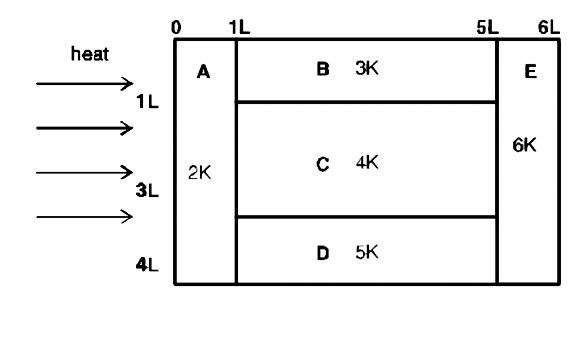
View SolutionThe figure below shows the variation of specific heat capacity (C) of a solid as a function of temperature (T). The temperature is increased continuousely form 0 to 500K at a constant rate. Ignorign any volume change, the following statement (s) is (are) correct to a reasonable approximation.
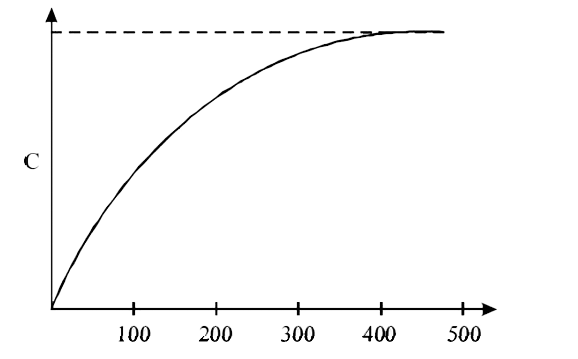
View SolutionA container of fixed volume has a mixture of a one mole of hydrogen and one mole of helium in equilibrium at temperature T. Assuming the gasses are ideal, the correct statement (s) is (are)
View SolutionAn ideal monoatomic gas is confined in a horizontal cylinder by a spring loaded piston (as shown in the figure). Initially the gas is at temperature `T_1`, pressure `P_1` and volume `V_1`and the spring is in its relaxed state. The gas is tehn heated very slowly to temperature `T_2`,pressure `P_2`and volume `V_2`. During this process the piston moves out by a distance x. Ignoring the friction between the piston and the cylinder, the correct statement (s) is (are)
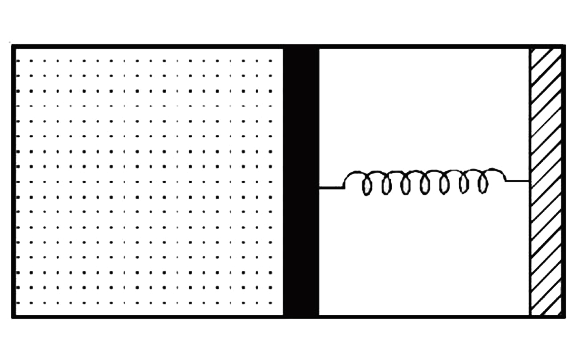
View SolutionA sinker of weight `w_0` has an apparent weight `w_1` when weighed in a liquid at a temperature `t_1 and w_2` when weight in the same liquid at temperature `t_2`. The coefficient of cubical expansion of the material of sinker is `beta`. What is the coefficient of volume expansion of the liquid.
View SolutionThree rods of material X and three rods of material Y are connected as shown in the figure. All the rods are of identical length and cross-sectional area. If the end A is maintained at `60^@C` and the junction E at `10^@C`. Calculate the temperature of the junction B, C and D. The thermal conductivity of X is `0.92cal//sec-cm^@C` and that of Y is `0.46cal//sec-cm-^@C`.
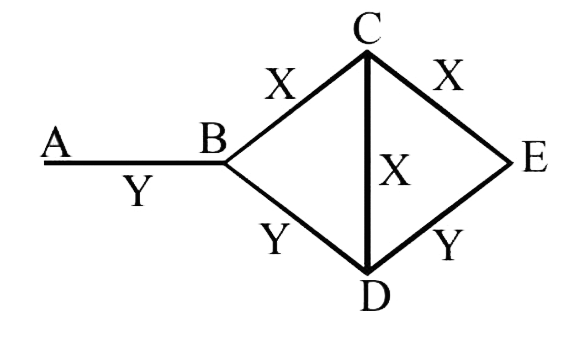
View Solution
JEE Main And Advanced questions and complete solutions for chapter HEAT AND THERMODYNAMICS of SUNIL BATRA 41 YEARS IITJEE PHYSICS (HINGLISH) of Class 11